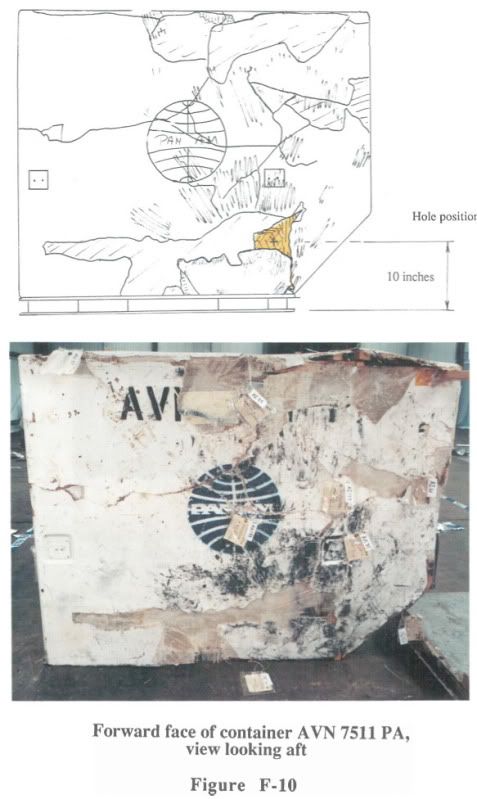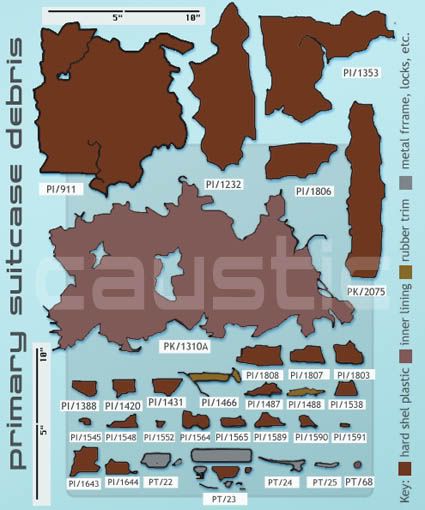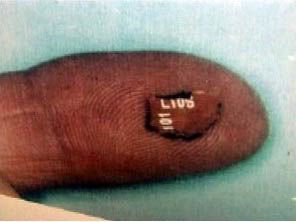Adam Larson / Caustic Logic
finished March 9 2010
last edit March 10 1am
An Urgent Inquiry?
Following the historic fall of Pan Am 103 onto Scotland, the world’s law enforcers and investigators sprang into action to sort out what had happened and how. A short six days after the bombing, on December 27 1988, a news article reported that:
“The New York-bound flight originated as a Boeing 727 from Frankfurt, West Germany, with a change of planes at London’s Heathrow airport. Federal police in West Germany and the commander of Scotland Yard’s anti-terrorist squad last week began investigations at those airports.” [1]
More properly, an official feeder flight called PA103A, a Boeing 727, brought 47 passengers and their luggage from Frankfurt to London, where 103 itself (a 747,
Clipper Maid of the Seas, with 243 passengers) originated. So about 20% of the flight originated in Germany, and if Pan Am had let a bomb through, it was at one of these two airports. So no surprise agents were swarming on both before Christmas Eve.
One German whose opinion matters here was airport employee Bogomira Erac, whose diligence seems to have solved the troubles we’ll deal with below. At the Zeist rtrial in 2000 she related first learning of PA103’s explosion en route to NY after work that night. “On the news it said the plane came from Frankfurt,” she testified. “I thought it was a direct flight. I didn't know anything more than that.”
[2] The better informed police knew the tragic flight had a partial start point at Frankfurt airport, and should have gone there looking for exactly one thing:
data on the luggage sent onto the plane that blew up.
German federal authorities with the BKA (BundesKriminalAmt) had at their disposal Frankfurt Main’s world-class computerized luggage system. This routed many thousands of bags a day on mechanized conveyors, every movement controlled and recorded by a central computer. All bags routed to 103A could be identified and tracked with some precision, compared with other flights and with paper logs. All of this should have been just a print command away.
The Eight-Month Blank Spot
The BKA came away empty-handed, it seems. Even working closely with their German counterparts, for eight months neither the Scottish police nor the FBI had direct record of the day’s luggage routing, not even for the feeder flight they were increasingly suspecting. Investigators were already, on their own, fudging away
John Bedford’s story with
unfounded forensic decisions about luggage arrangement to disprove a London origin. They were already speculating about a Khreesat bomb with modifications to fit it a journey from Frankfurt or beyond, without the hard data that would later back it up.
It wasn’t until mid-August 1989 that
the “Frankfurt printout” saved the day, and since then is touted as the revolutionary evidence proving the bomb came from Malta, through Germany, and only briefly passed through Heathrow. The blind interim of nearly eight months is often ignored, and when mentioned it’s usually pinned on mysterious German failings. David Leppard wrote that Senior Investigating Officer John Orr had been asking for the 103A records “since early January,” and noted “the delay was never satisfactorily explained by the BKA.”
[3] Leppard also mentioned the BKA’s own, earlier “work on the baggage-loading list, and wrote, damningly “had the BKA drawn the proper conclusions from their work […] it is likely that the bombers of PA103 would today be behind bars.”
[4]
As noted by Leppard, the BKA reports attached to the printout, the careful work showing a Malta origin bag with no passenger, were both dated February 2 1989. This does show a puzzling delay of six-and-a-half months before surrendering it to the Scots that has got to have an interesting explanation. However, another puzzle glossed over by Leppard and nearly everyone else on all sides of the Lockerbie issue, is why
the BKA themselves didn’t get the printout until over a month after the crash.
It’s no secret that Mrs. Erac, who printed this evidence as a personal keepsake the day after the attack, was never asked for it or offered it up until late January 1989.
[5] This means the BKA reports indeed were done upon belated receipt of the evidence.And the related and larger question is, since all agree that stray souvenir wound up being THE evidence for what went onto PA103A, why does no one seem to wonder or much care
why that was the case? Why hadn’t police gotten the relevant data right off the central computer on, say, December 22, like Bogomira did?
Live Data
From various readings and reasoning on my own part, the luggage routing system ran thus: each item of luggage was placed in a tray (“coded”), each with a unique number (or code, running approximately 00000-12000).
[6] The central computer would reconcile each tray number with a flight destination from the luggage tags. As the items kept in constant motion on mechanized conveyors, the central computer would read periodic scanner returns and direct the machinery to route each tray where it needed to go. Every signal sent to or from the computer could be stored in its active memory.
As the Zeist Court gave their understanding, in 2001: “it was possible, for a limited period, to identify all the items of baggage sent through the system to a particular flight. After some time, however, that information would be lost from the system.”
[7] A November 1991 article from the UK Observer, revealing the role of Mrs. Erac’ for the first time, explained:
“The vital computer evidence […] would have been lost forever if the woman operator had not kept her own record. […] She knew records relating to baggage loaded on to flights were kept in the system for only a limited time [eight days] before being wiped.” [8]
To be quite clear, the computers were running and recording on December 21, and the information was able to be printed, says the printout of the key data from the next day. That was held in the computer for eight days or a week in normal circumstances. Investigators were there by three days after a major airliner bombing presumably looking for a copy of just this data.
Printouts and Data Tapes
Now if we accept that the BKA had forgotten to snag this data on their presumed visit, we have a separate poor decision by the airport authority. The FAG (Frankfurt Airport Group) also must have failed to make an official copy before the memory was cleared. Legendary Lockerbie researcher Ian Ferguson was able to speak with an anonymous man described as “The expert who helped design the baggage system in place at Frankfurt airport in 1988 and familiar with the operating software”
"He was puzzled when he saw how short the printout out was and explained that there was no need to print a very small extract from the baggage system traffic, as a full back-up tape was made. This would have shown all the baggage movements at Frankfurt airport that day." [9]
Ferguson explained to the expert “that the system was purged every few days and that no back-up tape existed,” he responded: "This is not true." He admitted "of course it is possible no back-up tape was made for that particular day,” but explained that the FAG would usually keep such records simply to meet insurance claims for lost baggage.
[10] And they would surely learn within hours that a flight originating from there had exploded, and that a backup was still not ordered by them, on top of the failure of the feds to make a copy is… let’s just say troubling.
In contrast to the expert’s recollection, Mrs. Erac said in 2000 “it would be possible then to copy the data onto
disks.” [11] Somehow tape sounds more plausible in a system first set up in the mid-1970s, but disc storage, and perhaps a dual system would make sense. That this central brain would wind up blank by accident just when it was needed most seems unlikely.
Erac also spoke to routine paper printouts that would be kept on file for some time. A few days after her return from holiday, she recalls, “Mr. Berg just asked me to take a look in the archive in order to see whether there were teletype printouts. These were the things which came automatically from the computer. But I couldn't find anything.” [12] Routine prints gone. Special official prints not done. Tape or disk backup, routine or investigative, failed to appear. Police copies, nil.
But a personal memento copy, out of the investigative loop for weeks, altered for all we know, and certainly with no other copies to check against, is later acknowledged and accepted despite its broken chain of custody.
Listless in Pursuit of the List?
The only mentions one will find of the lack of early knowledge is in connection with the problem being solved by Bogomira’s Printout. The Observer’s introductory article of 1991 said that after her return from holiday in mid-January, “she was surprised to learn that no one had shown any interest in the computer records.” [13] Each has their own way of couching this odd failure; the BBC’s 2008 Conspiracy Files episode said "after the crash, surprisingly, the German police hadn’t fully investigated all the luggage records at the airport." [14] Having looked at all available information, I can safely say it’s a guess that the police just didn’t fully look – they either didn’t look at all for the one part they needed, or it wasn’t there when they looked, or they found it and then covered it up. It’s never been clarified which of these happened.
Whatever the book got wrong, Coleman and Goddard’s
Trail of the Octopus is useful in this area, summarizing the due incredulity over this development:
"If the new Malta/Libyan theory was to replace the established Iran/PFLP-GC scenario, it was necessary, first of all, to believe that no one thought to ask for the baggage-loading lists for Flight 103A as soon as terrorist action was suspected -- which was almost at once.
It was necessary to believe that no one in any of the British, German and American police, intelligence and accident inquiry agencies who had a hand in investigating the disaster, or anyone who was in any way involved with airport management or security at Frankfurt or London, thought to secure the baggage lists as the one indispensable tool that would be needed to unravel the mystery of how the bomb got aboard.
It was necessary to believe that the only person who considered the lists to be at all important was a lowly computer operator at Frankfurt airport." [15]
And finally, none too helpful is a discrepancy revealed in Leppard’s book regarding the February 1989 reports attached to the printout. For these, the BKA had interviewed Gunther Kasteleiner, in charge of baggage flow to 103A. His interviewer wrote into the report “by a coincidence, the record of baggage transported […] for flight PA103 on 21.12.88
is still stored in the computer.” [16] This report then is in stark contrast to the story we now have that it was all wiped well before then and the souvenir saved the day. Leppard does however say “the BKA had obtained a print-out of this record from Kurt Berg.” [17] This, we now know, was Bogomira’s supervisor, to whom she handed the printout and by whom it was taken to the BKA at the end of January. But investigators were saying that Berg had gotten this off the computer itself, a month after the police couldn’t find it there. That could be a simple erred presumption, or a sign that a shifting cover-story was attached to this, and it changed later.
Sources:
[1]“Crash Investigators Studying Suitcase; bodies identified.” The Arizona Republic December 27, 1988. Accessed March 5 2010 at:
http://plane-truth.com/Aoude/geocities/az3.html
[2] Camp Zeist trial transcription, Day 47, 30 August 2000. p 6662.
see also: full testimony, on-line posting.
[3] Leppard, David.On the Trail of Terror: The Inside Story of the Lockerbie Investigation. London, Jonathan Cape . 1991. 221 pages. p 151
[4] ibid. p 157.
[5] Erac testimony, p 6666
[6] Using the Erac printout as representative and randomly spread, its sequential tray numbers (with no connection to coding time) top off at 12224.
[7] In the High Court of Justiciary at Camp Zeist. Case no. 1475/99. Opinion of the Court. Delivered 31 January 2001. Paragraph 27. PDF link: http://www.scotcourts.gov.uk/library/lockerbie/docs/lockerbiejudgement.pdf
[8] Coleman, Lester and Donald Goddard. Trail of the Octopus - From Beiruit to Lockerbie, Inside the DIA. 1993. Online posting, chapter 7, unpaginated. http://11syyskuu.net/octopus/trail.ch.7.htm
[9], [10] Ferguson, Ian. The Judges Got it Wrong. Sunday Times (Malta) 10 May 2009. Re-post: http://lockerbiecase.blogspot.com/2009/05/from-sunday-times-malta.html
[11], [12] Erac testimony p 6668, 6666-67
[13] See 8.
[14] "The Conspiracy Files: Lockerbie." Prod/Dir Guy Smith, Ex Prod Sam Anstiss, Narr Caroline Catz. BBC Two. First Aired 31 August 2008. 25:12
[15] See 8.
[16], [17] Leppard, p 152








